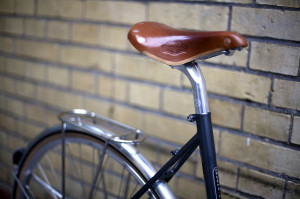 Riding a bicycle that does not properly fit your body can be a pain—literally. Adjusting your bicycle is crucial. Adjusting your bike can not only make a huge difference as to your efficiency when you ride, but it is also important in preventing serious pain and injury. Physioworks.com offers the following advice on how to adjust your bicycle in order to prevent serious injury:
Riding a bicycle that does not properly fit your body can be a pain—literally. Adjusting your bicycle is crucial. Adjusting your bike can not only make a huge difference as to your efficiency when you ride, but it is also important in preventing serious pain and injury. Physioworks.com offers the following advice on how to adjust your bicycle in order to prevent serious injury:
Foot Position
- The ball of your foot should be centered over the pedal axle.
- Small-footed and high-cadence peddlers place the ball of your foot slightly behind center.
- If you have clip-less pedals you can make this adjustment by clipping your shoes into the pedal and adjusting the cleat fixing bolts.
Seat Position
Set the seat height the following way:
- Sit on the saddle with the crank arm perpendicular to the ground and heel (shoes on) on the top of the pedal.
- Your leg should be in the straight “locked” position.
- Allow for oversized shoe heels or extra thick soles.
- Your saddle top surface should be parallel with the road surface.
Seat Front/Back Adjustment
- Sit on your bike in your normal riding position with the cranks in the 3 and 9 o’clock positions.
- Your saddle is correctly positioned when your tibial tuberosity (the bump at the top of the shin bone) is 1cm behind the pedal axle.
- You may need a plumb line and a helper to make this adjustment and you may have to readjust saddle height if you move the saddle significantly.
Stem and Handlebars
- Correct stem height can be somewhere between level with the saddle height or as much as 6 cm below. The preferred range is 2.5 to 4.5 lower.
- Check to ensure that your knee just clears your elbow when seated on your bike with the cranks in the 3 and 9 o’clock positions.
- To ensure good chest expansion and breathing, your handlebars should be as wide as your shoulders.
- On a mountain or hybrid bike, some riders may prefer a more upright riding position with a higher stem position.
- Extra wide flat-type mountain bike handlebars may give more stable control on unsealed roads, but you may find them uncomfortable on long rides over sealed roads.
- Bar extensions and narrower handlebars will give you a greater variety of comfortable hand positions, and also place your upper body in a slightly lower position to reduce your overall resistance to the wind.
Reach
If the handlebars are too far away, you will be very uncomfortable. To determine the proper handlebar reach, sit on your bike in your normal riding position. Your arms should be at a 90 degree angle to your torso.
Adjusting to Your New Position
It takes time to settle in to the new position and you may still have to do some fine tuning. Overall, you should feel much better when you ride and less strained when you arrive back home.
What if None of this Works?
If you can’t get comfortable after making these adjustments and riding for a while, then it is possible that your bike is not the right size for you. Considering visiting a physiotherapist with a special interest in bike setup or a cycling store professional.
Source: Physioworks
Photo Courtesy of: Tom Kirsche
